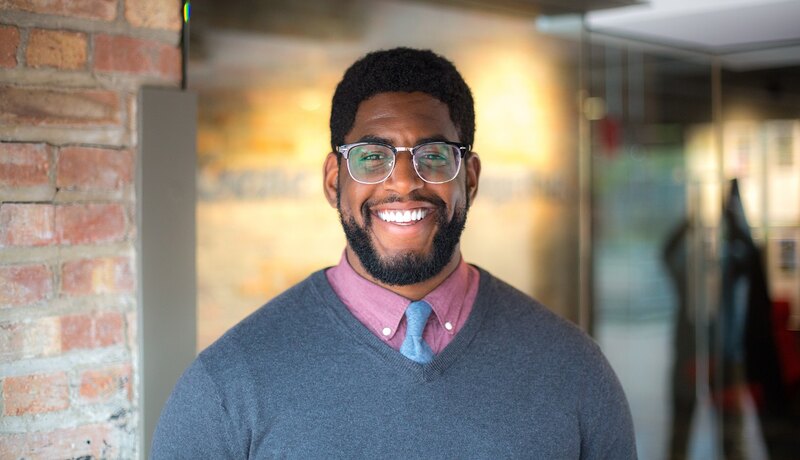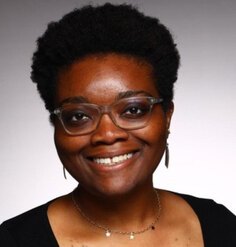Perspectives: Kene Okigbo

June 23, 2020
Kene Okigbo, ASLA is an emerging professional currently working as a Landscape Architectural Intern at RDG Planning & Design. As he pursues licensure, Kene also serves on numerous industry panels, including the American Society of Landscape Architects’ Government Affairs Committee, their Climate Action Committee, and Landscape Architecture Magazine’s Editorial Advisory Committee. Kene considers designing for the public realm an “awesome responsibility” and values the lessons being shared by his peers in the profession. He even imagines new mediums through which innovative voices in landscape architecture may be amplified.
What drew you to landscape architecture?
I loved the idea of design for community. I still do. I think there were two pivotal moments that sold me on pursuing this career. They both occurred during my freshman year. The first was during a lecture led by the upperclassmen where they shared their advice and experiences from the last 5 years. I remember not thinking of myself as a creative individual. I recognized that I thought and approached problem-solving a bit differently than most of my friends and family, but I wouldn’t have called it creativity. I asked if creativity could be learned. They said it could, meaning that the program would introduce me to the design process. That sold it for me!
The second moment occurred later in the year. We were given our first site design project and it would be a nearby plaza. The task was simply to envision the space differently by addressing some of the existing site conflicts. I took the opportunity to walk the site and found a man who knew the area well. We started talking and he told me all the secrets I would have never uncovered on my own. Learning those secrets is fun for me. Hearing what people care about is fun for me. The challenge of taking those disparate thoughts and putting them into a concise solution is incredibly frustrating… but even with that, it’s still fun! And on top of all of that, I get to work with people who think very differently than I do, but have the same goals of improving space for the communities and clients that we’re serving!
What resonates with me is that landscape architects never claim to know all the answers. What we bring to the table is hearing the voices of our clients and collaborators so that the final product provides value to the community. At its heart, landscape architecture is service-based leadership.
What is driving you professionally right now?
Ever since entering the world of landscape architecture I’ve been interested in design for different cultures. I’m a Nigerian who spent some of my formative years in Kenya before immigrating to the Midwest. The way people make space their own is fascinating. I’m interested in what people eat, where they play, and with whom. I want to incorporate that into my work more strongly. Recently I’ve been exploring the concept of Afrofuturism and how that world can intersect with landscape architecture. I don’t have the answer yet, but I feel like if these two subjects find a way to jibe, it’s not just a single-site solution, but a precedent for society.
Designers and educators that I respect and admire like Breeze Outlaw, Camille Applewhite, Kofi Boone, Diana Fernandez, Ujijji Davis, and Andrew Sargent are taking this idea and probing the way I think about space and the people who imbue it with life. Rather than what is driving me, these people and many more like them are pushing me to ask deeper questions. They’re driving me to be more confident in my inquisitiveness.
What challenges is landscape architecture allowing you to address right now?
Right now, we’re in the middle of an unprecedented pandemic. As a designer, I’m proud to have contributed to projects which created space for the public to engage with urban nature. Through landscape architecture I am able to help people who I have never met and may never meet, to exercise, earn grass stains, climb trees, build callouses, and watch clouds float by – all at a socially responsible six-foot physical distance from others doing the same. When I place trees in a parking lot, they are akin to moving the pieces of a chessboard against the urban heat island effect. When I advocate for higher water retention on-site, I’m advocating for less strain on municipal systems. When I specify a bench with no center armrests, I am embedding the intent that this space is welcoming to the person with nowhere else to go. Seemingly inconsequential decisions in the world of landscape architecture often have massive implications when you look at the experience of the end-use.
Designing the public realm is an awesome responsibility. In doing so, I think we begin to frame societal change. A challenge I have yet to tackle is the one of unintentionally aiding gentrification. I will optimistically proceed until we find a solution, but I cannot conform to the teachings of “just green enough.” It feels like a defeatist mentality with racist undertones. Do disadvantaged communities deserve anything less than our full-throated support? I’ll admit that I haven’t worked on many projects that touch this realm, but the subject matter and context hit close to home.
What challenge would you give emerging leaders?
I want emerging leaders to be bold and impatient, but I think they’re already doing that. I’ve been inspired by emerging leaders who are advocates for systemic reform in their local communities and on the nation’s stage. Robynne Heymans constantly encourages her peers to participate in Austin, Texas’ democratic process. ASLA Adapt’s ability to mobilize and hold their predecessors accountable for inaction, wrong action, and placation is literally awe-inspiring to me. Maggie Aravana has such a charming tenacity that you don’t even realize when you switched from disagreeing with her to arguing on her behalf. I’m floored by the passionate people who are poised to lead this profession.
If I had to choose one piece of advice, I would say you have to understand the systems you hope to advance/dismantle. Engage in local government. Engage in federal government. Join an ASLA committee. Become a board member of your local not-for-profit. Each one of these organizations has a system for collecting ideas and then implementing them. Infiltrate that system and embed your agenda. If the system is broken, you’re more prepared to substantively change it by engaging. If you take this advice, please don’t do it alone. I’ll paraphrase a quote from one of my favorite shows, The West Wing. “If you want to go quickly, go alone. If you want to go far, go with many. We have to go far, quickly.” There is so much for us to grow, change, dismantle, and rebuild. Remember to ask for help when it isn’t offered and to take it whenever it is.
Where do you think the profession needs to go from here?
If you will allow me to be facetious for a moment, I think we should be thinking about moonscaping and terraforming. What does the frontier after the next frontier look like?
In all seriousness, I think the profession needs to look more closely at the ramifications of the decisions we make. There should be a larger expectation that after construction, a review of design decisions be conducted on every project. The findings from these reviews should be freely exchanged among all firms and practitioners, preferably, on a no-cost public database.
I also think the profession needs to be more ubiquitous. This happens when we contribute our perspectives on mixed media along a broad spectrum of platforms. I love that Mike Todoran of the Landscape Architecture Podcast is advocating for more podcasts about landscape architecture and I truly appreciate how much effort the team behind Landscape Architecture Magazine puts into each issue, but I still think we need a few more James Wonders and Maggie Clarkes. Lastly, I would love to see a series of compelling landscape architecture design briefs. The stories behind the projects are so interesting! I want to know more about how and why projects exist, instead of the typical “what we did.” Docuseries like Abstract are brilliant and captivating tools to share the perspective of designers. Kate Orff, Kona Gray, and Diane Jones Allen would be perfect muses for an episode of a similar series. Compellingly sharing our message, to a diverse populous, is what we need.
LAF's Perspectives interview series showcases landscape architects from diverse backgrounds discussing how they came to the profession and where they see it heading. Any opinions expressed in this interview belong solely to the author. Their inclusion in this article does not reflect endorsement by LAF.











